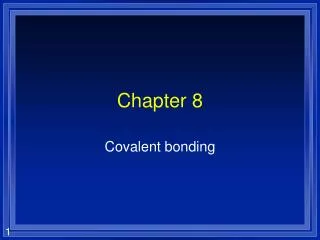CHAPTER 2: VALENCE BOND THEORY
CHAPTER 2: VALENCE BOND THEORY. HOMONUCLEAR DIATOMIC MOLECULES: VALENCE BOND (VB) THEORY. The word homonuclear is used in two ways:. A homonuclear covalent bond is formed between atoms of the same element, e.g. the H – H bond in H 2 , the O = O bond in O 2 and the O – O bond in H 2 O 2 .
Share Presentation
Embed Code
Link
Download Presentation
- single bond covalent radius
- sets chem210
- homonuclear molecule
- molecular orbitals
- third pair form
- sp3hybrid orbitals

maida + Follow
Download Presentation
CHAPTER 2: VALENCE BOND THEORY
An Image/Link below is provided (as is) to download presentation Download Policy: Content on the Website is provided to you AS IS for your information and personal use and may not be sold / licensed / shared on other websites without getting consent from its author. Content is provided to you AS IS for your information and personal use only. Download presentation by click this link. While downloading, if for some reason you are not able to download a presentation, the publisher may have deleted the file from their server. During download, if you can't get a presentation, the file might be deleted by the publisher.
Presentation Transcript
- CHAPTER 2: VALENCE BOND THEORY HOMONUCLEAR DIATOMIC MOLECULES: VALENCE BOND (VB) THEORY The word homonuclear is used in two ways: • A homonuclear covalent bond is formed between atoms of the same element, e.g. the H – H bond in H2, the O = O bond in O2 and the O – O bond in H2O2. • A homonuclear molecule contains one type of element, e.g. H2, N2 and F2and larger molecules such as O3, P4, S8 and C60. CHEM210/Chapter 2/2014/01
- Before discussing covalent bonding, we consider the following: • For an atom X, the value of the single bond covalent radius, rcov, is half the internuclear separation in a homonuclear X – X bond. • The van der Waals radius, rv, of an atom X is half of the distance of closest approach of two non-bonded atoms of X In covalent bonding, as two nuclei approach each other their atomic orbitals overlap. • As the amount of overlap increases, the energy of the interaction decreases. • At some distance the minimum energy is reached. • The minimum energy corresponds to the bonding distance (or bond length). • As the two atoms get closer, their nuclei begin to repel and the energy increases. At the bonding distance, the attractive forces between nuclei and electrons just balance the repulsive forces (nucleus-nucleus, electron-electron). CHEM210/Chapter 2/2014/02
- CHEM210/Chapter 2/2014/03
- A covalent bond forms when the orbitals of two atoms overlap and the overlap region, which is between the nuclei, is occupied by a pair of electrons. A set of overlapping orbitals has a maximum of two electrons that must have opposite spins. The greater the orbital overlap, the stronger (more stable) the bond. The valence atomic orbitals in a molecule are different from those in isolated atoms. There is a hybridization of atomic orbitals to form molecular orbitals. CHEM210/Chapter 2/2014/04
- CHEM210/Chapter 2/2014/05
- HYBRIDIZATION The number of hybrid orbitals obtained equals the number of atomic orbitals mixed. The type of hybrid orbitals obtained varies with the types of atomic orbitals mixed. sp hybrid orbital atomic orbitals hybrid orbitals The sp hybrid orbitals in gaseous BeCl2. CHEM210/Chapter 2/2014/06
- orbital box diagrams with orbital contours CHEM210/Chapter 2/2014/07
- sp2hybrid orbitals • When we mix n atomic orbitals we must get n hybrid orbitals. sp2 hybrid orbitals are formed with one s and two porbitals, therefore, there is one unhybridizedp orbital remaining. The large lobes of sp2 hybrids lie in a trigonal plane. All molecules with trigonal planar electron pair geometries have sp2 orbitals on the central atom. The sp2 hybrid orbitals in BF3. CHEM210/Chapter 2/2014/08
- sp3 hybrid orbitals sp3hybrid orbitals are formed from one s and three porbitals, therefore, there are four large lobes. Each lobe points towards the vertex of a tetrahedron. The angle between the large lobes is 109.5 The sp3 hybrid orbitals in CH4. CHEM210/Chapter 2/2014/09
- The sp3 hybrid orbitals in NH3. CHEM210/Chapter 2/2014/10
- The sp3 hybrid orbitals in H2O. CHEM210/Chapter 2/2014/11
- Geometrical arrangements characteristic of hybrid orbital sets CHEM210/Chapter 2/2014/12
- Composition and orientation of orbitals CHEM210/Chapter 2/2014/13
- MULTIPLE BONDS Have and -bonds. In -bonds, the electron density lies on the axis between the nuclei. All single bonds are -bonds. -Bonds: electron density lies above and below the plane of the nuclei. A double bond consists of one -bond and one -bond. A triple bond has one -bond and two -bonds. Often, the p-orbitals involved in -bonding come from unhybridized orbitals. CHEM210/Chapter 2/2014/14
- Ethane, C2H6 s-sp3 overlaps to σ bonds both Cs are sp3 hybridized relatively even distribution of electron density over all σbonds sp3-sp3 overlap to form a σbond CHEM210/Chapter 2/2014/15
- Ethylene, C2H4 One - and one -bond with both C atoms being sp2hybridized. • Both C atoms with trigonal planar electron pair and molecular geometries. CHEM210/Chapter 2/2014/16
- overlap in one position - σ p overlap - π electron density CHEM210/Chapter 2/2014/17
- Acetylene, C2H2 • In acetylene: • the electron pair geometry of each C is linear,therefore, the C atoms are sp hybridized. • the sp hybrid orbitals form the C-C and C-H -bonds. • there are two unhybridizedp-orbitals. • both unhybridizedp-orbitals form the two -bonds, one -bond is above and below the plane of the nuclei and the other -bond is in front and behind the plane of the nuclei. When triple bonds form (e.g. N2), one bond is always above and below and the other is in front and behind the plane of the nuclei. Electron density and bond order. CHEM210/Chapter 2/2014/18
- EXAMPLE Describe the types of bonds and orbitals in acetone, (CH3)2CO SOLUTION Use the Lewis structures to ascertain the arrangement of groups and shape at each central atom. Postulate the hybrid orbitals taking note of the multiple bonds and their orbital overlaps. π bonds σbonds CHEM210/Chapter 2/2014/19
- Delocalized π bonding So far all the bonds we have encountered are localized between two nuclei. In the case of benzene: • there are 6 C-C bonds, 6 C-H bonds. • each C atom is sp2hybridized. • there are 6 unhybridizedp orbitals on each C atom. CHEM210/Chapter 2/2014/20
- In benzene there are two options for the 3 bonds: • localized between C atoms or • delocalized over the entire ring (i.e. the electrons are shared by all 6 C atoms). Experimentally, all C-C bonds are the same length in benzene, therefore, all C-C bonds are of the same type (recall single bonds are longer than double bonds). CHEM210/Chapter 2/2014/21
- Restricted rotation of π-bonded molecules in C2H2Cl2 cis- trans- CHEM210/Chapter 2/2014/22
- General conclusions on multiple bonds • Every two atoms share at least 2 electrons. • Two electrons between atoms on the same axis as the nuclei are bonds. • bonds are always localized. • If two atoms share more than one pair of electrons, the second and third pair form bonds. • When resonance structures are possible, delocalization is also possible. CHEM210/Chapter 2/2014/23

Chemical Bonding and Nomenclature
Chemical Bonding and Nomenclature. Atoms can form molecules bonds: IONIC COVALENT METALLIC Get to know the difference between IONIC and COVALENT BONDS based on what happens with the valence electrons .h. LET’S FIRST REVIEW IONIC BONDING. Opposites Attract!.
911 views • 62 slides

Origin of the mixed alkali effect from RMC and bond-valence calculations
Outline. The new RMC constraint:- Calculation of bond-valence sum- Effects on the structureThe mixed alkali effect:- Introduction- Experimental results from neutron diffraction- Results from RMC based on neutron and x-ray diffraction data- Results from bond-valence calculations of cond
557 views • 26 slides

Chapter 11 Theories of Covalent Bonding
Chapter 11 Theories of Covalent Bonding. Theories of Covalent Bonding. 11.1 Valence Bond (VB) Theory and Orbital Hybridization. 11.2 The Mode of Orbital Overlap and the Types of Covalent Bonds. 11.3 Molecular Orbital (MO)Theory and Electron Delocalization.
937 views • 41 slides

Valence bond theory (VBT)
Valence bond theory (VBT) . There are theories as to why the links in the complexes and transition elements, : including Valence Bond Theory (V B T) We will study the hybridization. 1-Type of hybrid orbital's (sp 3 ): A) I nterdependence in methane :
10.22k views • 60 slides

Chapter 8
Chapter 8. Covalent bonding. Covalent Bonding. A metal and a nonmetal transfer electrons An ionic bond Two metals just mix and don’t react An alloy What do two nonmetals do? Neither one will give away an electron So they share their valence electrons This is a covalent bond.
1.17k views • 101 slides

CHAPTER 2
CHEMICAL BASIS OF LIFE. CHAPTER 2. Bohr’s Atom. electrons in orbits. nucleus. Nitrogen (N). 7. N. 14. 7 e-. Electron valence: 6. C. O. Valence: 2 (8- 6 = 2) Unpaired e - = 2. Electron valence: 5. O. N. Valence: 3 ( 8- 5 =3) Unpaired e - = 3. Electron valence : 4. N.
522 views • 33 slides

VSEPR Theory and Valence bond theory
VSEPR Theory and Valence bond theory. Learning Outcomes At the end of this presentation the students will be able to: Explain VSEPR Theory 2.State the postulates of Valence bond Theory . V alence S hell E lectron P air R epulsion Theory.
1.45k views • 8 slides

CHAPTER 4: MOLECULAR ORBITAL THEORY
CHAPTER 4: MOLECULAR ORBITAL THEORY. It is clear that hybridized valence bond theory does not explain much of the observed phenomena for small molecules such as paramagnetism or UV absorption and a better theory needs to be introduced to rationalize these experimental observations.
3k views • 16 slides

Lecture 24 Valence bond theory
Lecture 24 Valence bond theory.
449 views • 24 slides











